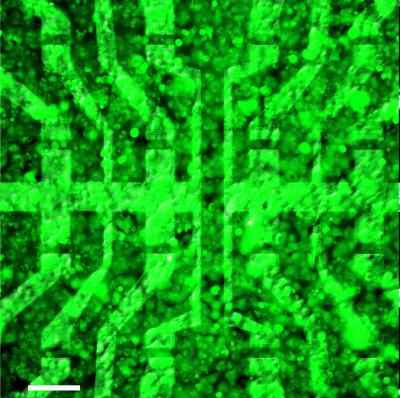Researchers at the Juelich Research Center and the Technische Universitaet Muenchen have for the first time shown a transistor array based on graphene that can be used with live biological cells and can record the electrical signals generated by the cells, paving the way for studying the possibility of developing bioelectronics based on graphene.
 This combination of optical microscopy and fluorescence imaging shows a layer of biological cells covering a graphene-based transistor array. The experimental device, created by scientists from the Technische Universitaet Muenchen and the Juelich Research Center, is the first of its kind to prove capable of recording signals generated by living cells, with good spatial and temporal resolution. With this demonstration, the researchers have opened the way to further investigation of the feasibility of using graphene-based bioelectronics for potential future applications such as neuroprosthetic implants in the brain, the eye, or the ear. (Credit: Copyright TU Muenchen)
This combination of optical microscopy and fluorescence imaging shows a layer of biological cells covering a graphene-based transistor array. The experimental device, created by scientists from the Technische Universitaet Muenchen and the Juelich Research Center, is the first of its kind to prove capable of recording signals generated by living cells, with good spatial and temporal resolution. With this demonstration, the researchers have opened the way to further investigation of the feasibility of using graphene-based bioelectronics for potential future applications such as neuroprosthetic implants in the brain, the eye, or the ear. (Credit: Copyright TU Muenchen)
Graphene has high chemical stability and superior electronic performance. It is biologically inert and ready to be processed with flexible substrates at a lower cost and larger scale. The unique properties of graphene make it a suitable candidate for bioelectronic applications wherein a direct interface is needed between live tissue or nerve cells and microelectronic devices.
During the study, the researchers used a sequence of 16 graphene solution-gated field-effect transistors (G-SGFETs) produced over a copper foil using standard photolithographic and etching and chemical vapor deposition processes. They developed a biological cell layer analogous to the heart muscle directly over this array. The transistor array was not only capable of detecting single cells’ ‘action potentials’ that were beyond the transistors’ inherent electrical noise but also recording these cellular signals with high temporal and spatial resolution. In separate tests conducted for identifying the G-SFETs’ intrinsic noise level confirmed that the level is equivalent to that of ultralow-noise silicon devices.
TUM’s Walter Schottky Institute member, Dr. Jose Antonio Garrido stated that the team’s research is mainly targeted at enhancing the graphene devices’ noise performance and transferring this technology to flexible substrates such as kapton and parylene that are utilized in vivo implants. The team is also focused on enhancing the spatial resolution of its graphene devices, Schottky said.
The research team is also partnering with the researchers at the Vision Institute based in Paris to study the graphene layers’ biocompatibility in retinal neuron cell cultures and with NEUROCARE, a major European project focusing on devising brain implants using flexible nanocarbon devices.